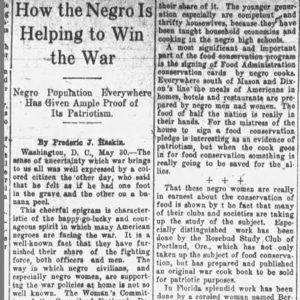calsfoundation@cals.org
Arkansas Colored Auxiliary Council of Defense
President Woodrow Wilson and the U.S. Congress established the Council of National Defense on August 29, 1916, with the purpose of coordinating “industries and resources for the national security and welfare” of the country in the event that the United States became involved in World War I. This national council oversaw investigations of infrastructure, troop movement, supply mobilization, production and distribution of propaganda, organization of civilian population, and the nation’s capability to produce materials, all with the intention of supporting a war effort. To facilitate the national council’s efforts, the whole of the United States had to be broken down into smaller groups to mobilize local communities’ civilian populations. Smaller councils were established at the state and county level, including councils for women and African Americans. The Arkansas Colored Auxiliary Council of Defense was established in 1918 as part of this effort.
Ten months after President Wilson established the Council of National Defense, and fifty days after the United States declared war on Germany on April 6, 1917, Arkansas’s governor, Charles Brough, formed the Arkansas State Council of Defense on May 22, 1917. The state council organized seventy-five county councils, roughly 5,000 community councils, the Women’s Council, and the Colored Auxiliary Council. These smaller local organizations were successful in reaching rural communities and monitoring the circulation of information.
The Colored Auxiliary County Council of Defense would not have been established without outside pressure on the states in the South from the Council of National Defense. On February 23, 1918, Arthur Fleming, who worked for the national council, wrote a letter to several southern states, stating, “The Negro population can render valuable assistance in the present crisis.” Federal authorities wanted this population of Americans to organize and contribute to the war effort, but they also desired to maintain control and not upset the status quo of racial segregation. In order to push Arkansas into organizing the black community, Fleming wrote, “It will also prevent the over-emphasis which would result from different Federal agencies approaching the Negroes independently and which, as you can readily see, might create in their minds a disastrous misconception of their importance.”
By July 1918, however, Arkansas still had not organized a council from within the state’s black communities, and Fleming began threatening to send in the federal authorities to begin the organization process. He also stated that “some organization of the Negroes is inevitable. It is important that the state council should take the initiative in effecting that organization.” Fleming reminded Arkansas’s white governing officials that they could, in effect, control how the black community was to operate within the state if they took the lead rather than allowing the federal government to step in. The federal government suggested that the black county council should be comparable to the other county councils in organization and work under their direction.
On August 11, 1918, the Arkansas Gazette reported that more than thirty counties in Arkansas planned to have county councils focused upon and run by black members of that county. The establishment of the Council of National Defense had been two years prior; fifteen months after the start of the Arkansas State Council of Defense, the Arkansas Colored Auxiliary County Council of Defense had its first meeting Little Rock (Pulaski County) on August 10, 1918. This council was under the supervision of John Bond, state education superintendent, and Wallace Townsend, the director of the state council from September 1917 until it dissolved in July 1919. Highly influential black attorney and community leader Scipio A. Jones served as the state chairman of the Colored Auxiliary Council, tasked with organizing and running the council’s agenda.
In the way it went about setting up the Colored Auxiliary Council, however, the national council preemptively inserted itself as a paternalistic guiding force that viewed itself as aiding the black organizing effort while at the same time maintaining control over the black community. When Fleming of the national council sent state councils in the South material on how to organize the black community in the best way to benefit the war effort and still maintain white jurisdiction, he said, “A county council of Negroes should be created. It should be parallel to the county council in organization and should work under its direction. In most cases the Negroes will no doubt be pleased to have representative of the other body present at their meetings.” This allowed for white supervision at all meetings conducted by the Colored Auxiliary Council, which was perceived as necessary by the national council.
For additional information:
Arkansas Colored Auxiliary Council. https://arkansascouncilofdefense.com/ (accessed December 17, 2021).
Arkansas Council of Defense Records. Arkansas State Archives, Little Rock, Arkansas.
Polston, Michael D., and Guy Lancaster, eds. To Can the Kaiser: Arkansas and the Great War. Little Rock: Butler Center Books, 2015.
Senn, Gerald Allen. The Arkansas State Council of Defense, 1917–1919. Houston: University of Houston, 1977.
Shurley, Crystal. “The Arkansas Colored Auxiliary Council: Black Activism during World War I, 1917–1918.” MA thesis, University of Arkansas at Little Rock, 2018.
Crystal Shurley
Arkansas State Archives
 Early Twentieth Century, 1901 through 1940
Early Twentieth Century, 1901 through 1940 Military
Military African-American War Support
African-American War Support 




Comments
No comments on this entry yet.